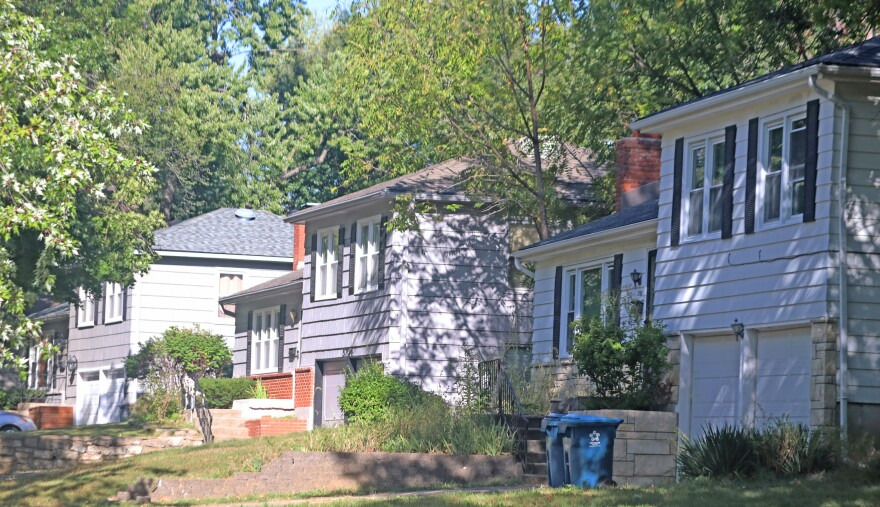In the last nine years, Carol Schenk of Wichita has seen the assessed value of her home increase from $152,000 to $240,000 — pushing her annual property tax bill from $2,200 in 2014 to more than $3,000 in 2022.
Schenk told lawmakers in a letter earlier this year that the tax on her nearly 30-year-old home is becoming too much.
“I can’t even imagine what my new tax bill will be,” Schenk said, “but I am struggling to afford it right now.”
Many Kansans have lined up at public meetings to say rising property values and the taxes that come with them are out of control. Kansas Republican and Democratic lawmakers have taken notice. But they are proposing rival amendments to the state constitution in an attempt to reel in rising property taxes.
The Republican-backed plan would cap how much property values can increase each year. That would hopefully standardize increases for taxpayers and spare them from large spikes year to year.
The Democratic proposal wants to shift some of the burden of property taxes off of residential homeowners and onto commercial and agricultural real estate. But that will be a tough sell to the Republican leaders of the Legislature who are more business and agriculture friendly.
However, both proposals only address one side of the property tax equation. Neither change would be able to stop local governments from increasing their tax rates. So homeowners could still see a spike in property taxes when their cities and counties raise their mill levies.
Additionally, a tax expert argues big changes to property tax codes can come with unintended consequences that are hard to reverse. Richard Auxier, senior policy associate for the Tax Policy Center, said a better strategy is targeting relief at specific groups, like retired homeowners.
“You would much rather go slow,” Auxier said, “And not overextend yourself, then try and go back and fix something that you’ve done.”
Capping rising value
The Republican plan calls for capping yearly increases to property valuations at 4%.
The amendment passed the Senate with a 28-11 vote, mostly following party lines. The House can consider advancing it to send it to voters during the 2024 legislative session.
Republican Sen. Caryn Tyson said on the Senate floor that many states cap increases to property values, including states from both sides of the political spectrum like Oklahoma and Oregon.
The plan allows for exceptions to the cap, like new construction adding value to the home or when a home is sold. So when someone purchases a house, the suppressed property value for tax purposes will revert to its true assessed value.
Auxier argues the plan disproportionately benefits people who have owned their home longer than their neighbors. That can mean someone who’s lived in their home for decades paying significantly lower property taxes than someone who just bought a house down the street.
“The person who bought it last year,” Auxier said, “pays an astronomical rate because the government needs to catch up. And so you get these big disparities.”
But Republican Senate President Ty Masterson has the plan is fair because the new homeowner knows they are purchasing a house that will spike in tax value.
Shifting the burden
Meanwhile, the Democratic plan calls for reducing the taxable amount on residential properties. Currently, homes are taxed on 11.5% of their value. The proposal would drop that to 9%.
However, commercial property and agricultural land would not see a similar reduction. So owners of that kind of land would end up paying more in taxes to make up the difference. That’s likely to run into opposition in the Republican-controlled Legislature.

Democratic Rep. Vic Miller, the minority leader in the House, said the proposal would begin shifting the property tax burden away from homes and onto businesses and agricultural land. He said that’s necessary because homeowners have gradually been taking on more of the property tax burden in the state over the last 30 years.
Kansas voters last changed the property tax code in the state constitution in 1992, when the 11.5% rate was created. That change led to homeowners paying 35% of the total collected property taxes in Kansas, while commercial and agriculture made up the other 65%.
The homeowner portion of the pie gradually increased over the years and now makes up more than half, 56%, while commercial and agriculture paying the other 44%.
Miller said that the proposal would shift the residential portion down, making a 50-50 split between taxes collected from homes and other properties. He said that would help address how home values are rising much faster.
“It’s been shifting over time onto homes away from the other properties,” Miller said. “This would simply make some corrections to that shift.”
The agriculture industry and the Kansas Chamber, one of the largest lobbying groups in the state, oppose the plan unless the similar property tax relief offered to residential homeowners was provided to commercial and agricultural land as well.
Targeted approaches
Auxier argues both plans may be too wide-reaching and could cause a significant decline in tax revenue for local governments that won’t be easy to fix.
He said lawmakers should consider targeted tax policies that help a specific group to make sure they don’t accidentally throw the entire tax structure out of whack.
Some examples of targeted approaches include providing property tax breaks to people who are older than 65 years old or lower income And tax cuts are more useful when they are addressing a specific situation, like helping young families purchase a home or helping retired residents remain in their houses.
“There are numerous ways to limit property taxes,” Auxier said. “But it would be a lot better if you explained why, and who specifically we’re trying to help.”
Source : KCUR

